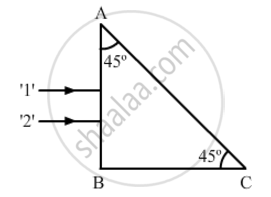Advertisements
Advertisements
Question
What kind of fringes do you expect to observe if white light is used instead of monochromatic light?
Solution
White light consists of waves of all wavelengths starting from violet to red colour. If the monochromatic light in Young’s interference experiment is replaced by white light, then the waves of each wavelength form their separate interference patterns. The resultant effect of all these patterns is obtained on the screen.
The path difference between waves starting from S1 and S2 at the location (M) of central fringe is zero, i.e., for point M of screen S1M − S2M=0 i.e., the waves of all colours reach at midpoint M in the same phase. Therefore the central fringe (at M) is white. As fringe width ω = Dλ/d or ω ∝ α and in visible region wavelength of violet colour is least and that of red colour is maximum, i.e., wavelength increases in the order of colours denoted by VIBGYOR therefore on either side of it some coloured fringes are obtained in order of colour VIBGYOR. That is the violet (V) fringe appears first and the red (R) the last. After this, the fringes of many colours overlap at each point of the screen and so the screen appears uniformly illuminated.
Thus if we use white light in place of monochromatic light the central fringe is white, containing on either side a few coloured fringes (in order VIBGYOR) and the remaining screen appears uniformly illuminated.
APPEARS IN
RELATED QUESTIONS
Two monochromatic rays of light are incident normally on the face AB of an isosceles right-angled prism ABC. The refractive indices of the glass prism for the two rays '1' and '2' are respectively 1.35 and 1.45. Trace the path of these rays after entering the prism.

State the essential conditions for diffraction of light ?
Monochromatic light of frequency 5.0 × 1014 Hz is produced by a laser. The power emitted is 3.0 × 10–3 W. Estimate the number of photons emitted per second on an average by the source ?
Can the interference pattern be produced by two independent monochromatic sources of light? Explain.
State with reason, how the linear width of the central maximum will be affected if
(i) monochromatic yellow light is replaced with red light, and
(ii) distance between the slit and the screen is increased.
Answer the following question.
In the diffraction due to a single slit experiment, the aperture of the slit is 3 mm. If monochromatic light of wavelength 620 nm is incident normally on the slit, calculate the separation between the first order minima and the 3rd order maxima on one side of the screen. The distance between the slit and the screen is 1.5 m.
Using the monochromatic light of the wavelength in the experimental set-up of the diffraction pattern as well as in the interference pattern where the slit separation is 1 mm, 10 interference fringes are found to be within the central maximum of the diffraction pattern. Determine the width of the single slit, if the screen is kept at the same distance from the slit in the two cases.
For constructive interference to take place between two monochromatic light waves of wavelength λ, the path difference should be ______.
Monochromatic light of wavelength 600 nm is incident from the air on a water surface. The refractive index of water is 1.33. Find the
- wavelength,
- frequency and
- speed, of reflected and refracted light.
A ray of monochromatic light propagating in the air is incident on the surface of the water. Which of the following will be the same for the reflected and refracted rays?
